For UC Berkeley, 2022 was a year of speaking out and looking ahead
Here's a roundup of some of the top Berkeley News stories of the year
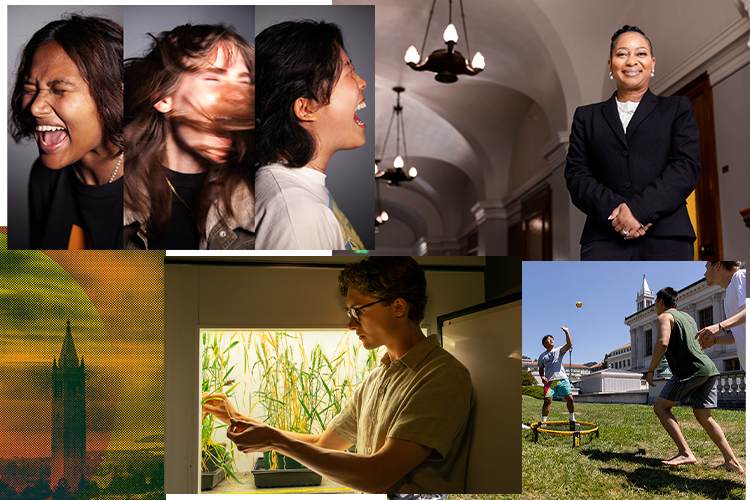
December 13, 2022
For UC Berkeley, 2022 was a year of speaking out — against injustice, against violence, against the patriarchy — and committing to a better future, together.
When Russia waged war on Ukraine in February, the campus community joined in solidarity and voiced its outrage and defiance. When Iranians rose up in protest against their repressive government and called for freedom, Berkeley students, staff and faculty spoke out in support of the protesters and what they stood for. And students on campus screamed together for the art project OUTCRY.
When Berkeleyans weren’t speaking out, they were working to build a better future. A new series about the climate crisis highlighted the ways the campus is fighting for climate justice and finding solutions, from considering the role of reparations in delivering climate justice to highlighting the snow lab’s critical mission to drilling a 400-foot borehole to explore geothermal heating on campus.
And, as always, researchers made world-changing discoveries, and the campus started a slate of new initiatives and projects to build a stronger, more inclusive community for everyone. Here’s a look back at some of the top Berkeley News stories of the year.
January

In January, Russia had massed troops and military equipment near its borders with Ukraine, but denied charges by the U.S. and others that it was planning a military assault. (Associated Press photo)
Could Ukraine be a tombstone for Russian power? Or for the Western alliance?
In January, Russia was massing troops, tanks and material on its snowy borders with Ukraine, and the consensus among many Western observers was that President Vladimir Putin could launch a limited attack or full-scale invasion at any time. Two veteran Russia scholars, George Breslauer and M. Steven Fish, both political scientists at Berkeley, offered compelling insights into Putin’s immediate objectives in Ukraine and his overarching vision for Russia. They also reflected on the U.S. response to Putin’s military threat, the field options for both sides and possible long-term scenarios.

An artist’s depiction of NASA’s James Webb Space Telescope. (Image courtesy of NASA’s Goddard Space Flight Center)
Berkeley astronomers to put new space telescope through its paces
NASA’s latest and snazziest mission, the James Webb Space Telescope, launched on Christmas Day, deployed its 21-foot-wide mirror and, at the end of January, reached its orbital destination. With a flashy new telescope now nearly a reality, astronomers at UC Berkeley are chomping at the bit to start observing.
After months of anxiety about whether the $10 billion telescope — 25 years in the making and the successor to the highly successful Hubble Space Telescope — would even survive launch, let alone unfold from its chrysalis into a gold-blinged telescope, Berkeley astronomers felt confident enough to plan summertime observations of nearby galaxies and of some of our closest neighbors in the solar system.
Also, read: Surprising details leap out in sharp new James Webb Space Telescope images of Jupiter; Webb Telescope images Jupiter-like planet 350 light years away and Webb Space Telescope, Keck team up to study Saturn’s moon Titan.
February
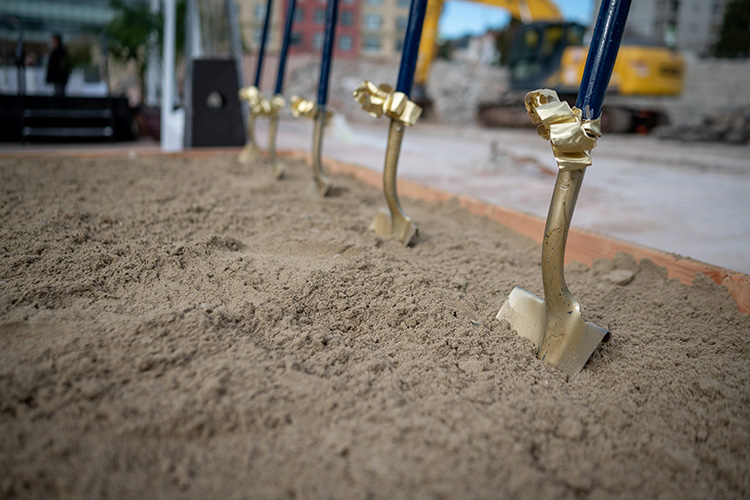
The Helen Diller Anchor House, an apartment-style housing project for transfer students, is anticipated to open for the 2024-2025 academic year. (UC Berkeley photo by Keegan Houser)
UC Berkeley breaks ground on Helen Diller Anchor House
In February, construction had begun on a 772-bed, apartment-style housing project for UC Berkeley transfer students, designed, built and funded by the Helen Diller Foundation. The 500,000 square-foot building, named Helen Diller Anchor House, will be gifted to Berkeley upon its completion and is anticipated to be open in time for the 2024-2025 academic year. Rent for each housing unit will be below market rate, and the building will require no public funds to construct or operate.
Also, read: Construction to begin on below-market apartments that will triple graduate student housing capacity.
Lessons on wildfire resilience from a 4,000-acre forest lab
For more than 50 years, UC Berkeley forestry researchers have used Blodgett Forest Research Station, a 4,000-acre experimental forest in the northern Sierra Nevada, as a living laboratory. They use it to study how different land management treatments — including prescribed burning, restoration thinning and timber harvesting — can reduce the risk of severe wildfire and improve a forest’s resilience to the impacts of climate change. In addition to research, Blodgett regularly hosts workshops to demonstrate different land management techniques to landowners.

In February, mezzo-soprano Alicia Hall Moran and jazz pianist Jason Moran — and a roster of collaborators — performed Two Wings: The Music of Black America in Migration for UC Berkeley’s Cal Performances. (UC Berkeley illustration by Neil Freese)
Between 1910 and 1970, about 6 million Black Americans moved from the rural South to cities in the North, the West and other parts of the United States. It’s known as the Great Migration. Musicians who moved to these cities became ambassadors, says UC Berkeley history professor Waldo Martin, not only for the music of the South, but for the culture from which the music emerged. And the music was made and remade, and continues to be today.
In February, mezzo-soprano Alicia Hall Moran and jazz pianist Jason Moran — and an all-star roster of jazz collaborators — performed their remaking of the music in Two Wings: The Music of Black America in Migration for UC Berkeley’s Cal Performances.

With Russian troops bearing down on Ukraine’s major cities in Feburary, those in Berkeley’s Ukrainian community were defiant. “We Ukrainians — we will not let Putin win,” said one. (UC Berkeley illustration by Neil Freese; map courtesy of Free Vector Maps)
With defiance and solidarity, Berkeley’s Ukrainian scholars respond to invasion
In the hours immediately following Russia’s invasion of Ukraine in February, Berkeley News asked Ukrainian faculty and students at UC Berkeley for their reactions. Their thoughts ranged across issues of family, geopolitics and justice. But each of them, in their own ways, expressed shock and defiance — and hope that the global community would rally to protect democracy and freedom.
Also, read: For Berkeley scientist Polina Lishko, a time of sadness and anger for Ukraine; Will the free world defend my native Ukraine from authoritarian aggression?; Student Vitaliia Yaremko: ‘I’m more proud than ever to be Ukrainian’; A month at war: Berkeley’s Ukrainian students turn shock, anger into action and listen: Berkeley Talks: UC Berkeley experts on the invasion of Ukraine.
March

People’s Park in early 2022. (UC Berkeley photo by Jeremy Snowden)
Campus, city form model alliances to aid unhoused people in People’s Park
Novel partnerships unveiled in February — one between UC Berkeley, the city of Berkeley and several local nonprofit organizations, and the other between the campus, the city and a local church — would support unhoused individuals who lived and gathered in People’s Park, where work would begin in the summer on urgently needed student housing and on an open space revitalization project.
Also, read: Chancellor Christ announces new partnerships for People’s Park; Tough job, light touch: Campus social worker assists area’s homeless; Berkeley’s new daytime center opens for unhoused community; State leader visits Berkeley, praises novel partnership to help the unhoused.
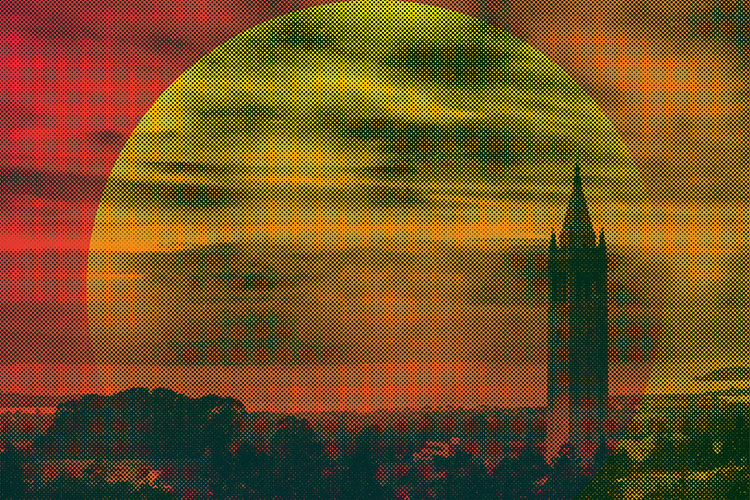
A new Berkeley News series launched in March explores how UC Berkeley faculty, staff and students are confronting the ongoing impacts of climate change. (UC Berkeley illustration by Neil Freese)
The Climate Crisis: Justice and Solutions
A new Berkeley News series launched in March explores the many ways that UC Berkeley faculty, staff and students are creating innovative climate solutions and implementing them in ways that ensure a more just and equitable future for our planet.
Also, watch: With climate change, Berkeley snow lab’s mission remains critical; UC Berkeley drills 400-foot borehole to explore geothermal heating on campus; and listen: Biologist confronts deep roots of climate despair.
See all stories in the series.
April
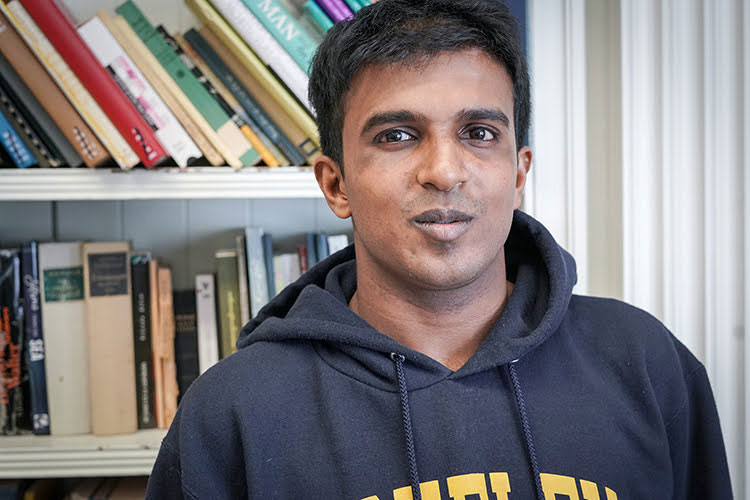
In April, student Hari Srinivasan was the first nonspeaking person to win a prestigious Paul & Daisy Soros Fellowship for New Americans. (Photo courtesy of Hari Srinivasan)
‘Minimally speaking autistic’ student wins Soros fellowship for Ph.D.
In April, Hari Srinivasan, who graduated with a bachelor’s degree in psychology in spring 2022, was the first nonspeaking person, or as he puts it, “minimally speaking autistic,” to win a prestigious Paul & Daisy Soros Fellowship for New Americans. He received $90,000 to fund his Ph.D. studies in neuroscience at Vanderbilt University in Tennessee.

Vince Medina (left) and Louis Trevino are co-founders of Café Ohlone. (UC Berkeley photo by Sofia Liashcheva)
A healing collaboration: Café Ohlone moves onto Berkeley campus
“A love song to Ohlone culture” took shape in April on the south patio of UC Berkeley’s Hearst Museum of Anthropology. There, Vincent Medina and Louis Trevino were creating a new home for Café Ohlone, an outdoor educational culinary event series where groups of ticketed visitors spent 30 minutes taking a walking tour of the evolving site and tasting the foods of the co-founders’ community, the Ohlone.
May

Anjika Pai was the 2022 winner of the University Medal. (UC Berkeley photo by Neil Freese)
In top graduating senior, East Coast grit meets Berkeley utopianism
In May, Anjika Pai, an environmental sciences major and music minor with a 4.0 GPA, was the 2022 winner of the University Medal, UC Berkeley’s highest honor for a graduating senior. The prize came with $2,500. Pai addressed thousands of her peers at a campuswide commencement ceremony at California Memorial Stadium. In fall 2022, she headed to Northeastern University in Boston to study environmental law on a full-tuition graduate scholarship.
Read other student profiles: In times of crisis, 2022 University Medal finalists summoned resilience, hope; Social workers were her ‘saving grace.’ Now, she’s going to be one; Graduating student Ockemia Bean: ‘Build a community that will support your dreams.’

May’s commencement in 2022 — a jubilant celebration under clear blue skies — was the first commencement exercise held at California Memorial Stadium since 2019. (UC Berkeley photo by Keegan Houser)
In rollicking ceremony, UC Berkeley graduates cap a challenging college education
The giddy May ceremony drew the largest attendance in recent history for Berkeley’s annual all-campus commencement. Graduates could hardly sit still, and speakers thrilled at the turnout and energy. Even parents, grandparents and other supporters in the stands performed a rippling, rollicking, spontaneous group wave with their arms outstretched as roughly 7,500 graduates filed in.
Also, listen: Berkeley Talks: Timnit Gebru on how change happens through collective action and watch the full commencement ceremony.
See all spring 2022 graduation stories.
June

University Health Services medical director Anna Harte said that UHS strives to create an environment in which everyone in the campus community feels welcome. In this photo, protestors march against a bill restricting transgender girls from sports teams in Pierre, South Dakota, in March 2021. (AP photo by Toby Brusseau for Human Rights Campaign)
How UC Berkeley became a leader in trans care
To honor Pride Month in June, Berkeley News talked with University Health Services director Anna Harte, who created the Transgender Care Team in 2012. With partners across UHS, Harte formed an interdisciplinary trans care team that includes primary care providers, mental health clinicians, a care manager, a psychiatrist, an insurance specialist and medical assistant support staff. In 2022, students joined the leadership team for the first time — “which is fantastic,” said Harte. Now, UHS at Berkeley is regarded as a national leader in interdisciplinary trans care.

After the Supreme Court decision overturning the constitutional right to an abortion in June, law professor Khiara M. Bridges said the ruling would jeopardize the well-being of less-privileged people in red states. (AP photo by Jacquelyn Martin)
Khiara M. Bridges: Court abortion ruling is an assault on women — and democracy
In June, the U.S. Supreme Court, carried by its conservative majority, voted 6-3 to overturn Roe v. Wade and Planned Parenthood v. Casey, historic decisions that enshrined the right to abortion over the past half-century. UC Berkeley legal scholar Khiara M. Bridges said the decision will jeopardize the well-being of less-privileged people in red states, while representing a symbolic threat to women everywhere.
Also, read: Chancellor Carol Christ: Roe ruling is a major setback for women; UC Berkeley reaffirms commitment to full-spectrum reproductive health care; Supreme Court abortion ruling will radiate deep into American lives, scholars say; and listen: Berkeley Voices: How Roe v. Wade radically changed American culture.

Evan Groover, a UC Berkeley graduate student in the Innovative Genomics Institute labs of David Savage and Brian Staskowicz, examines a rice plant that has been edited using CRISPR techniques. (Photo credit: Neil Freese, UC Berkeley)
In 10 years, CRISPR transformed medicine. Can it now help us deal with climate change?
An $11 million commitment from the Chan Zuckerberg Initiative announced in June would help Innovative Genomics Institute researchers at UC Berkeley, UC Davis and Lawrence Livermore National Laboratory rapidly assess CRISPR gene editing in plants, primarily rice and sorghum, and hopefully get improved varieties into field trials in three to five years.
“The advent of CRISPR basically allowed us to create new molecular tools for potentially skipping the slow aspects of plant tissue culture and plant genetic engineering, which are large barriers to doing experiments in plants,” said Savage, associate professor of molecular and cell biology at UC Berkeley, an investigator in the Howard Hughes Medical Institute and member of the Innovative Genomics Institute, which focuses on the myriad uses of CRISPR-Cas9 genome editing.
July
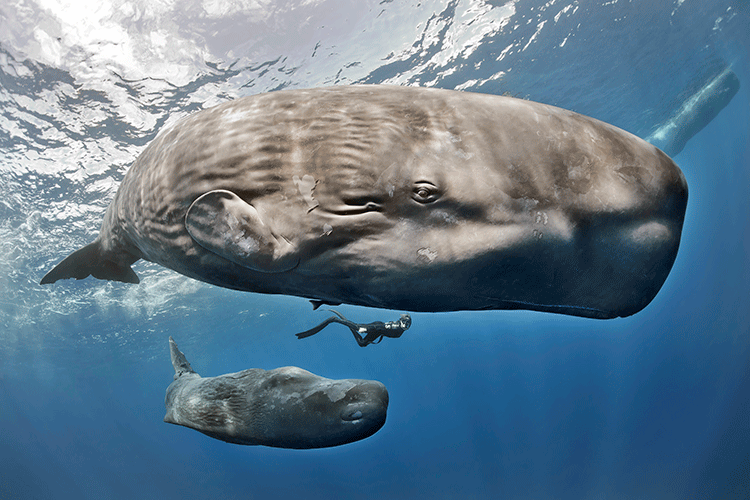
Berkeley researchers are part of a multidisciplinary project aimed at cracking sperm whales’ Morse code-like communications off the Caribbean island of Dominica. (David Salvatori/VWPics via AP Images)
A race to converse with, and save, the oceans brainiest eco-predators
UC Berkeley linguist Gasper Begus and computer scientist Shafi Goldwasser are part of an international team of researchers attempting interspecies communication with sperm whales by deciphering their deafening, 200-plus decibel clicking sounds, or codas. They are among the key members of the Cetacean Translation Initiative, a five-year multidisciplinary project aimed at cracking sperm whales’ Morse code-like communications off the Caribbean island of Dominica, to gain a deeper knowledge of the ocean’s brainiest predators and to preserve their habitat from further human disruption.
August

A game of spikeball among a group of new UC Berkeley students on Memorial Glade eases the transition to the start of fall instruction. (Photo by Brittany Hosea-Small)
No shortage of good news as fall semester 2022 begins at UC Berkeley
The reopening of popular Moffitt Library, vending machines dispensing free COVID-19 tests, the 50th anniversary of Title IX, the 125th Big Game, unprecedented state funding for students from several historically excluded communities, an expanded Basic Needs Center and a visiting Chicago artist who will photograph women screaming in rage were highlights of the start of UC Berkeley’s new academic year.
Also, read: Student Clarissa Arceo: ‘Some doors close so others can open’ and listen: Berkeley Voices: Author Charles Yu: ‘Interior Chinatown’ is about roles and how we play them.
See all back-to-school stories.

UC Berkeley postdoctoral scholar Chi Zhu is part of a team of researchers developing a new COVID-19 therapeutic that can be administered as a nasal spray. The experimental treatment is effective against all SARS-CoV-2 “variants of concern” and could be readily modified to target other RNA viruses. (Photo by Brittany Hosea-Small)
New inhaled COVID-19 therapeutic blocks viral replication in the lungs
In a study published in August, a UC Berkeley team of scientists showed that short snippets of synthetic DNA, called antisense oligonucleotides (ASOs), are highly effective at preventing COVID-19 from replicating in human cells. When administered in the nose, these ASOs are also effective at preventing and treating COVID-19 infection in mice and hamsters.
September

Dancers perform Lenora Lee Dance’s Within These Walls on Angel Island. (Photo by Lenora Lee Dance)
Angel Island arts project explores immigration, architectures of incarceration
A Year on Angel Island: Immigration Histories and Futures is a yearlong, campuswide project by Berkeley Arts+Design and Future Histories Lab. The project is sponsoring a series of music and dance performances, exhibitions and public conversations, using Angel Island’s immigration station as a jumping-off point to start discussions about race, global migration and architectures of incarceration. “It’s already deep in the fibers of the campus,” said Wymore in September. “This project is making the work visible and allows people to see our cross-connections, not only for ourselves, but for our students and community.”

Berkeley Journalism students Christian Collins and Meiying Wu demonstrate the school’s focus on local reporting as they film a PBS NewsHour segment about how early planning in San Francisco’s Chinatown helped lessen the impact of COVID-19. (Photo courtesy of Berkeley Journalism)
State funds Berkeley Journalism $25 million to strengthen California’s local news coverage
In September, the UC Berkeley Graduate School of Journalism announced that it would launch a $25 million, state-funded fellowship program in spring 2022 that aimed to support and strengthen local reporting in underserved and historically underrepresented areas across the state.
What is believed to be the largest state allocation ever made in California and in the U.S. to support local journalism, the new Berkeley fellowship program awards up to 40 fellows per year for at least three years with a $50,000 annual stipend to supplement their salaries while they work in California newsrooms covering communities in dire need of strong local journalism.
Bringing arsenic-safe drinking water to rural California
Like many areas throughout California, the groundwater beneath Allensworth, a historically Black community in the Central Valley, is tainted with dangerous levels of arsenic, a highly carcinogenic element that can seep into the water table from deposits in the soil and bedrock. While cities and larger municipalities can afford to remove arsenic from their water, many people living in small and rural communities are forced to choose between drinking contaminated tap water or purchasing bottled water — and those with private wells may not even know that their water is unsafe.
In collaboration with Hutson and other Allensworth community leaders, engineers at UC Berkeley are field testing a simple and low-cost new arsenic treatment system that is designed to help small, rural communities like Allensworth access arsenic-safe drinking water.
Also, read: Study finds potentially dangerous levels of arsenic in prison drinking water.

A student-run tech company collaborated with the UC Berkeley community to launch an app that elevates the Black student experience on campus. (UC Berkeley graphic by Neil Freese)
A digital revival: Startup Blackbook University continues Berkeley legacy
Blackbook University is a UC Berkeley tech startup founded in 2019 by Berkeley students and alumni to combat institutional inequities in higher education by using digital tools to enhance the Black student experience. The company’s website provides Berkeley’s Black students with online access to academic and professional resources and offers career opportunities, such as internships for students interested in tech entrepreneurship. Blackbook University’s social media channels also bring attention to Black student experiences on campus through video profiles of Black students who tell personal stories about what it means to be Black at Berkeley.
October
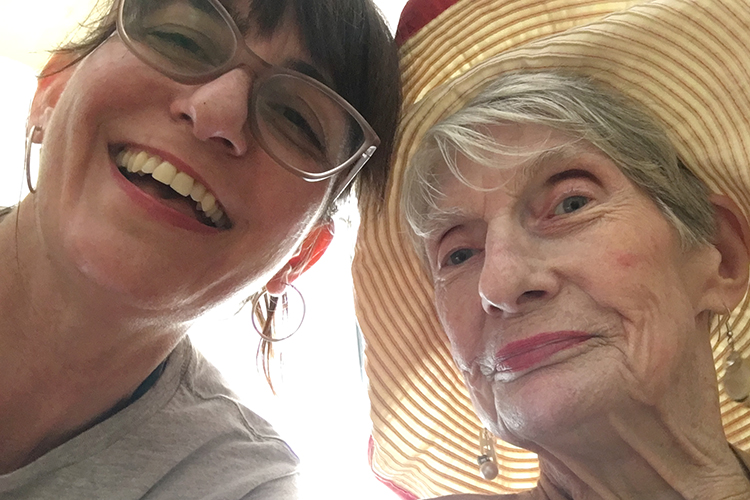
Diana Stasko (left) is the social media marketing manager at UC Berkeley’s School of Public Health and the chair of the Staff Alliance for Disability Access. Her mother, Shirley (right), has been a strong role model for Stasko throughout her life. “She’s a strong, outspoken, unconventional woman,” Stasko said. (Photo courtesy of Diana Stasko)
Disability alliance chair Diana Stasko: ‘My mom was a very strong role model’
“My mom was a very strong role model for me,” said Diana Stasko, social media marketing manager at the School of Public Health and chair of the Staff Alliance for Disability Access, in October. “She’s a strong, outspoken, unconventional woman who was in a wheelchair from about the age of 65 and on. Prior to that, she used a walker, and prior to that, she used a cane. So, for almost all of my growing up, my mom was ‘disabled.’
“Like my mom, I have Charcot-Marie-Tooth. It’s a neuromuscular disease, and it’s degenerative. In my family, there were many people with disabilities, whether it was that or something else. I just watched them do whatever they had to do from their wheelchairs. My grandmother cooked and coordinated huge family dinners for 40 people from her chair. My mom would go everywhere and anywhere in her chair — she rode the bus all over town.
“Since I was in my early 20s, I have known exactly what I was facing. The emotional impact of that sneaks up on me.”
Also, read: How community spaces can empower students to mobilize, explore their identity and listen: Berkeley Talks: Judith Heumann on the long fight for inclusion.

Protesters chant slogans with red-painted hands and faces during a demonstration on Oct. 11. The protest was held in front of the Iranian Consulate in Istanbul, Turkey, in response to the death of Mahsa Amini, who died in police custody in Iran after being detained for allegedly not wearing a head scarf (hijab) “properly” in public. (Photo by Onur Dogman / SOPA Images / Sipa USA via AP)
‘A mix of hope and sorrow’: Campus community reflects on Iran uprising
In the weeks since 22-year-old Mahsa Amini died in the custody of Iran’s morality police, Iranians in their country and across the world have risen up in defiance of Iran’s restrictive and violent treatment of women. Their demonstrations have captured the attention of the world and have been met with violent crackdowns by the Iranian government.
In October, Berkeley News spoke with five members of the Iranian campus community about how they’d been affected by the death of Amini, the protests and the brutal government response.
Also, listen: Law student Hoda Katebi: Iran protests are about ‘total liberation.’

The campus celebrates the grand opening of UC Berkeley’s Latinx Student Resource Center. (Photo by Raul Hernandez)
Berkeley’s new Latinx Student Resource Center creates family away from home
Berkeley’s Latinx Student Resource Center serves as a home for the Chicanx/Latinx Student Development Office. It opened at the beginning of the fall 2022 semester and is the first physical community space dedicated for Chicanx/Latinx students on Berkeley’s campus.
“I am feeling full of love and energy,” center director Lupe Gallegos-Diaz told Berkeley News in October. “This center is a culmination of the history of the movement, and our story of love, all coming together from the many different generations that we’ve had here. And we’re here to celebrate now that we have a space where people can come to feel loved, respected and accepted.”
November
Berkeley students scream together for art project ‘OUTCRY’
Artist Whitney Bradshaw is the creator of a project called OUTCRY. In it, women scream. As loud as they want. Whatever they want. With other people or by themselves. It’s a practice, says Bradshaw, that encourages them to use their voices to speak up and out for themselves. “The more you practice it, the easier it becomes,” she said.
In October, Bradshaw visited UC Berkeley and held two scream sessions with students at the Berkeley Art Museum and Pacific Film Archive (BAMPFA). A rotation of photos from OUTCRY were on display on BAMPFA’s huge outdoor screen.
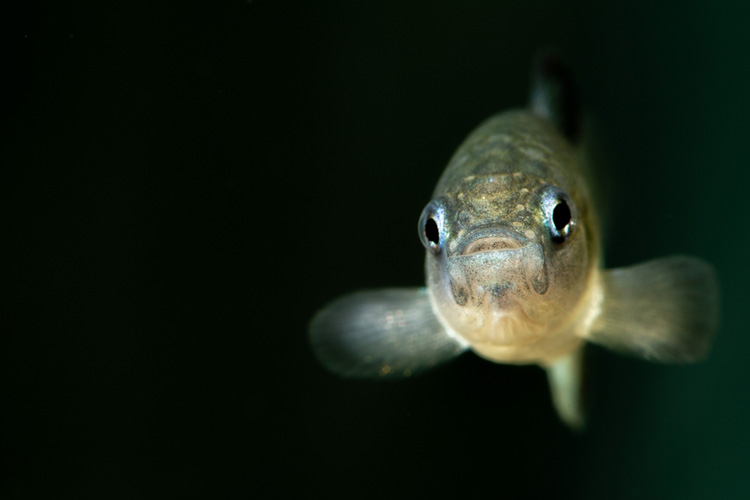
A curious, captive-raised Devils Hole pupfish at the Ash Meadows Fish Conservation Facility in Nevada. The facility maintains a refuge population of pupfish as a backup to the wild population, which fluctuates over decades and once dipped to a mere 35 individuals. (Photo by Olin Feuerbacher/USFWS)
Endangered Devils Hole pupfish is one of the most inbred animals known
As its name implies, the Devil’s Hole pupfish lives in a truly hellish environment.
Confined to a single deep limestone cave in Nevada’s Mojave Desert, 263 of them live in water that hovers around 93 degrees Fahrenheit year-round, with food resources so scarce that they are always on the edge of starvation, and with oxygen levels so low that most other fish would die immediately. The pupfish, Cyprinodon diabolis, live in the smallest habitat of any known vertebrate.
New research now documents the extreme effect that these harsh and isolated conditions have had on this fish’s genetic diversity.

Tina Trujillo, a faculty member at the Graduate School of Education, helped launch and serves as faculty director of the Certificate Program in Psychedelic Facilitation at the UC Berkeley Center for the Science of Psychedelics. (Photo by Daphne Hougard)
Psychedelic guides trained in first-ever UC Berkeley program
There’s a resurgence in psychedelics, banned since 1970 by the federal Controlled Substances Act. That law, signed by then-President Richard Nixon, halted what had been promising research into the drugs’ therapeutic and medicinal potential. Today, psychedelics have been shown in recent, approved clinical trials to alleviate mental distress, even addiction. As a result, efforts to legalize their use also are on the rise.
In the fall, 24 people in a first-of-its-kind training program at the year-old UC Berkeley Center for the Science of Psychedelics are learning to safely guide patients’ psychedelic experiences in therapeutic and research settings. The group of advanced professionals chosen for the nine-month, 175-hour program includes doctors, nurses, social workers, psychologists, chaplains and others.
Also, read: Doctoral student’s goal: Access to psychedelics for Indigenous peoples.
Massive traffic experiment pits machine learning against ‘phantom’ jams
Many traffic jams are caused by human behavior: a slight tap on the brakes can ripple through a line of cars, triggering a slowdown — or complete gridlock — for no apparent reason. But in a massive traffic experiment that occurred outside of Nashville in November, scientists tested whether introducing just a few AI-equipped vehicles to the road can help ease these “phantom” jams and reduce fuel consumption for everyone. The answer seems to be yes.
December
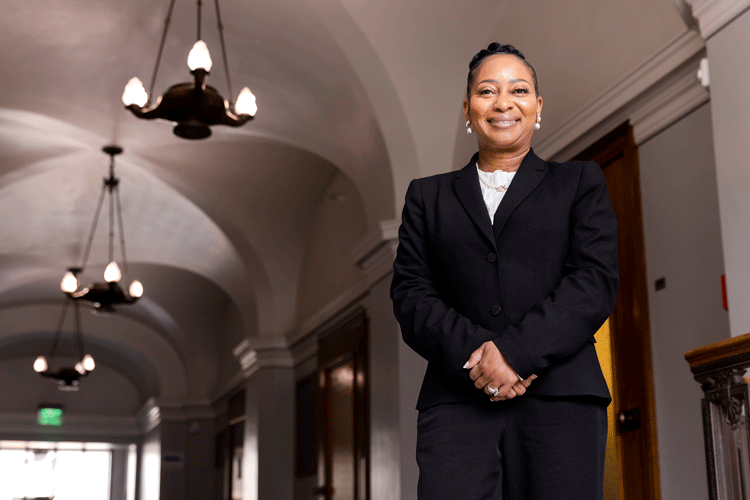
Yogananda Pittman, the incoming chief of the UC Berkeley Police, said she will respect the community’s diversity and listen to many voices as the department works to improve campus security. (Photo by Brittany Hosea-Small)
For new UC Berkeley chief, building trust is the key to modern police work
In the hours after the January 6 mob attack on the Capitol, veteran police leader Yogananda Pittman faced a profoundly difficult choice: She was offered the position of interim chief of the U.S. Capitol Police, a post for which she’d been preparing for nearly two decades. It would mean taking charge of a department that was reeling and certain to face intense scrutiny and pressure to reform. Two days after the insurrection, she became the first Black woman to lead the Capitol Police.
In December, it was announced that, after helping to guide the force through a time of crisis and rapid change, Pittman would become chief of the UC Berkeley Police Department. “To achieve change,” said Pittman, “it helps to have leaders who have deep professional experience, but who also know the perspective of people who have been on the receiving end of unfortunate encounters with law enforcement.”
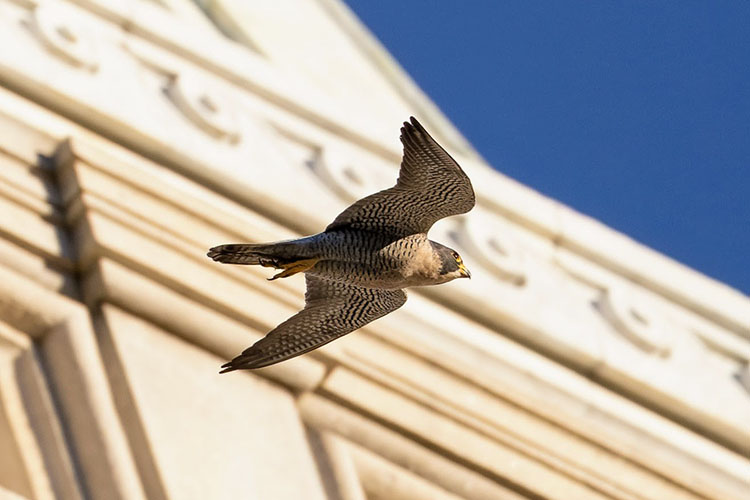
With Alden absent from the Campanile for two weeks at the end of the year, a new male peregrine falcon, shown here, caught Annie’s attention. (Photo by Bridget Ahern)
It’s been a year of drama for Berkeley’s falcons. What’s ahead in 2023?
UC Berkeley gets predictably quiet this time of year, as the semester ends and the campus empties for the holidays. But a few hundred feet above academia, atop the Campanile, life for Berkeley’s falcons remains unpredictable at the end of 2022, a year that included Grinnell’s death in March, Annie’s quick selection of new mate, Alden, and young Lindsay’s demise in August.

Many people who find it hard to wake up in the morning blame it on their constitution or their genes. But how you slept, what you ate for breakfast and the amount of physical activity you engaged in the day before have a lot more to do with your ability to wake up alert. (Shutterstock image)
Scientists discover secret to waking up alert and refreshed
Do you feel groggy until you’ve had your morning joe? Do you battle sleepiness throughout the workday?
You’re not alone. Many people struggle with morning alertness, but a study published in December demonstrated that awaking refreshed each day is not just something a lucky few are born with. Scientists at UC Berkeley discovered that you can wake up each morning without feeling sluggish by paying attention to three key factors: sleep, exercise and breakfast.